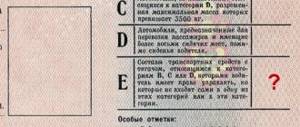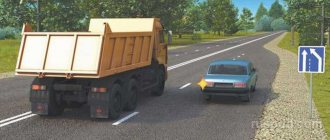Towing a vehicle with a flexible hitch
Towing a car with a flexible hitch is the most common method of towing passenger cars.
A flexible hitch, which is usually a fabric cable, is present in the trunk of almost every car owner. And the point here is not that drivers care about the problems of possible towing. Usually the cable, along with a fire extinguisher, a warning triangle and a first aid kit, is included in the motorist’s kit, so it willy-nilly ends up in almost any trunk.
An example of towing with a flexible hitch is shown in the following picture:
In practice, in addition to the towing cable, special towing mounts will also be required. On some cars, the mounts are lugs that stick out from under the bumpers. On others, you should use a special loop that is screwed into the mount under the plug in the bumper.
It is with a flexible hitch that category B cars are most often towed.
Features of car towing
Towing a car begins with the fact that both drivers must agree on conditional signals to be given to each other in case of unforeseen situations. The speed during towing cannot be more than 50 km/h. The choice of speed depends on weather conditions and road conditions.
The hazard lights must be on on both vehicles. It is advisable, if possible, that the engine of the towed vehicle should be running, otherwise it will be more difficult to brake.
By and large, towing a car is a kind of art. The tractor driver must be able to start moving smoothly, take into account turning angles, etc. The driver of an emergency vehicle is the same; he must be able not to slow down the movement of the tractor, take into account turns and constantly ensure that the cable is taut. Definitely art.
These are the rules for towing vehicles with manual transmissions: smooth clutch release, smooth gear shifting. Towing a car with automatic transmission has some nuances.
What should it be
What is necessary for successful and authorized transportation of a vehicle by towing:
- Serviceability of brake and steering systems.
- Integrity of the body covering - there should be no breaks or pointed pieces bent outward (if the car has been in an accident).
- Serviceability of door hinges, handles, glass.
- Carabiners and other elements of the connecting device must be in good working order.
- A flexible clutch requires a certain length of cable.
- For rigid fastening - a special device made of durable and high-quality metal.
When transporting a passenger car, a flexible hitch option is suitable. But to transport a truck or passenger vehicle, a rigid hitch is required.
With the latter type of towing, the trajectory of the second vehicle will not deviate. Thus, during travel there will be no unnecessary interference for other participants.
Rope length
The cable should not be shorter than 4 meters and longer than 5 meters. It should be taken into account that the longer the flexible clutch equipment is, the greater the risk of deviation of the trajectory when moving.
If the cable is shorter than the specified norm, then there is a high risk of a collision between the driven vehicle and the vehicle pulling it.
The color of the cable does not matter. The accumulation of steel fibers is impregnated with reflective compounds.
In the case of using a red and white cable with a “reflector” effect, it is allowed not to attach striped signs. Such cables themselves signal and serve as a means of issuing warning signals.
Most often you can find products made from threads of the following shades and their combinations:
- red;
- orange;
- blue;
- blue and white;
- white with red;
- orange and white;
- other variations.
Speed also plays a role in the presence of a particular length of cable. Even driving slowly by the lead driver will not allow the trailing motorist to drive perfectly smoothly.
This is why it is required that the second (transported) car be driven by a person who is always ready to correct the motion vector in a timely manner.
Travel speed
The main postulate of the Rules regarding the speed limit applies to almost all types of vehicles and in all cases of towing. One rule applies to everyone.
Permitted speeds when towing another vehicle:
| within the boundaries of the village | no more than 50 km/h |
| outside the city, town, along the highway | no higher than 40 km/h |
| in case of independent movement of the coupled car | no more than 80 km/h |
| with attached trailer | no more than 70 km/h |
If a car has an automatic transmission and is subject to forced removal from its location on the roadway, then it must be driven exclusively at a speed of 30 km/h - no more.
The only thing is that if the number of gears is more than 3 stages, it is allowed to transport the vehicle at an increased speed, but not more than 50 km/h.
Prepare both vehicles before towing
The towing vehicle should not differ much in weight from the towed one and have an unworn clutch assembly, as well as a fully functional cooling system, since when towing the engine heats up more than usual. Screw the towing eye into the special thread in the rear bumper or under it, or find it under the bottom in the rear of the car. Hook the cable onto it and if you have a choice, do it in such a way that it is located “obliquely” in relation to the towed car. That is, for example, it was attached to the left side of the tug and at the same time to the right side of the towed one. When driving, you must turn on the low beam.
Attach the cable to the towed vehicle as recommended above.
You need to tie a bright fabric to the cable every meter so that it is visible.
Start the engine and use the heater to warm up the interior until the windows thaw.
If the engine does not start, clean the windows manually to have sufficient visibility in all directions and open the window slightly so that the windows do not “sweat” from the inside. If the engine does not start, be sure to turn the ignition key to the “battery” (first “click”) or “ignition on” (second “click”) position to unlock the steering column - otherwise, at the first turn, the steering wheel will be locked in the turned position. Before driving, turn on the hazard warning lights or attach a warning triangle to the rear of the vehicle.
Features of a rigid coupling
This method of towing is carried out using a solid structure, one end of which is attached to the driving vehicle, the other to the driven one. It allows both vehicles to be kept on the same line while driving, which ensures reliability and safety.
Therefore, a rigid vehicle coupling is especially useful for moving heavy, clumsy equipment. It will prevent cars from colliding with each other.
Inventions
Mercedes-Benz has invented an electronic collar for trailers. The new system is called Trailer Stability Assist (TSA). It is fully integrated into the vehicle's existing electronic stability control system. TSA quickly detects the beginning of a skid or lateral sway of the trailer and effectively suppresses these movements by alternately braking the right and left front wheels of the vehicle.
Not all drivers are familiar with the rules for towing vehicles: in driving schools little time is devoted to this section, and in practice, not many have tested themselves as a driver of a towing or towed vehicle.
In a real traffic situation, the lack of theoretical and practical knowledge causes certain difficulties.
Introduction
Sometimes even cars that have proven their efficiency over many years can break down at the most inopportune moment, and even a minor malfunction can lead to the failure of the entire vehicle, in which case the car will need to be towed.
Most car enthusiasts who, by luck, managed to avoid such a nuisance as towing their own car, may not even be aware of the problems that fate may face them. Almost everyone theoretically imagines towing as a simple process, for which you just need to stop some driver on the road, who will agree to attach a tow rope to his vehicle and pull the unfortunate thing to the nearest parking lot or service center. In practice, everything is much more serious and complicated, which is why we will consider the possibility and rules according to which the car should be towed.
So, if, nevertheless, there is a problem on the road with a car that simply “refuses” to move at least a little, it will be better if the driver first familiarizes himself with the towing rules. In this case, it is important to have some driving experience.
The only thing worth focusing on before even starting to talk about the principles of performing such a procedure is the fundamental difference between towing a car equipped with an automatic transmission and towing a vehicle with a manual transmission. However, despite a number of differences, both transmissions have some common rules that contribute to proper towing of the vehicle.
Rules for towing with a rigid hitch
Towing a vehicle with a rigid hitch
First of all, traffic regulations prohibit towing in any case if the steering of the towed vehicle is faulty - it can only be transported by partial or full loading. Sometimes they write that when hitching with three attachment points, it is not necessary for the driver to be behind the wheel of the towed car - this is an erroneous idea that contradicts the requirements of the traffic rules.
The driver of the towing vehicle must have at least 2 years of driving experience. The dimensions of the rigid coupling must be such that the distance between the machines is no more than 4 meters. The weight of a towed vehicle with a non-working brake system should not exceed half the weight of the “tug”.
Types of vehicle towing
There are several types of towing:
- The most common is towing with a flexible hitch. It is used using a flexible metal or nylon cable. This option is permitted if the towed vehicle’s control system, including brakes, chassis and steering wheel, is fully operational. The rope must be at least 4-6 meters long.
- Towing with a rigid hitch is a connection using a device assembled from durable steel pipes and angles. There are 2 types of these couplings: a simple rod (pencil) and a triangle. The second hitch option allows you to tow a disabled vehicle without a driver behind the wheel.
- Towing by loading. This is an option for transporting a faulty vehicle by partially or completely loading it onto a truck. In the first case, only half of the towed vehicle is brought onto the scow, the rest of the vehicle rides on wheels. Full loading is similar to transportation by tow truck.
Towing with a flexible hitch
Towing is considered one of the most difficult technical techniques. The law even allocates a special section of the traffic rules regulating the provisions of this method of transporting a faulty car.
Towing can be carried out in different ways, but it is the flexible hitch that is carried out most often, because most motorists drive passenger cars. A rigid coupling is inconvenient and requires a special lift. But a flexible hitch requires just one strong rope. Therefore, in the vast majority of cases, towing is carried out in this way.
Flexible coupling has limitations:
- it is prohibited during icy conditions;
- it is not used to transport motorcycles;
- You cannot tow 2 or more cars with a cable;
- It is prohibited to transfer vehicles with a non-working steering wheel or faulty brakes.
Recommendations for a driver planning to tow with a flexible hitch.
- First, make sure that the hook (earring) is working properly and that it is securely fastened. There should be no corrosion spots near the eyelet. If anything is in doubt, it is better to immediately refuse towing.
- According to unwritten rules, the cable must be offered by the driver of the towed vehicle. If the rope is not suitable, you need to offer your own.
- Check the cable length. If it is short, it threatens in the event of a collision braking. If it is too long, the towed vehicle will constantly deviate from the trajectory, and it is possible that it will jump onto the side of the road and into a ditch, as well as into the oncoming lane. It is better to avoid an emergency situation from the beginning by refusing such towing, or replace the cable with a high-quality one.
- Increase the reliability of the cable fastening. It is recommended to pass one end through the hook of the towed vehicle, and install a special carabiner at the continuation of the rope.
- Be sure to agree with the driver of the towed car about warning signals. For example, frequent “blinking” of the headlights will mean a request to stop, and a raised right hand will be a sign before braking.
- Don’t be shy to ask your colleague if he has worn a tie before. If not, then you need to familiarize yourself in detail with the nuances of the operation of the systems and components of the car when towing: the hydraulic brake pedal will require much more force when pressed, a key must be inserted into the lock, the driver's side window must be lowered. In winter or cold autumn, you need to warn the driver to dress warmly, because the stove will not work.
- On your car, set the lighting to the factory mode so that you can clearly see what maneuver the tractor is about to perform.
- Start as smoothly as possible, without making a jerk. Brake, avoiding sharp and unexpected pedal presses in a timely manner. It is advisable to drive at a speed of 30-50 km/h.
Following these rules will help you avoid many troubles. Not only a metal cable, but also a nylon rope, which is also not inferior in strength, can be used as a flexible hitch.
Towing with a rigid hitch
This is a towing option that is rarely used by car owners due to its inconvenience and complexity. However, this particular method of trailering is the most reliable, because it allows you to connect two vehicles to each other as firmly as possible.
The main thing in a rigid coupling is a special device assembled from a beam with eyes and a metal pipe. There is also another, more complex device that allows you to tow a faulty car along the path of the lead vehicle.
A rigid coupling is much safer, because a stable distance is ensured between cars. This completely eliminates jerking or approaching.
According to the law, the driver (pencil) must sit behind the steering wheel of a vehicle towed by a rigid coupling, and the distance must not exceed 4 meters. It is also not allowed to transport a car with faulty brakes and steering.
Partial towing
Transporting a machine with a partial load is a more complex type of towing. To implement this method, you will need a large SUV and a crane to lift the front of the car.
This vehicle transfer option is often used for new cars and trucks. This is the safest and most convenient method of transporting cars over short and medium distances.
Although safe, partial loading has its legal restrictions.
Towing with a rigid hitch
Unlike towing with a flexible hitch, in which the tow rope can sag to the ground, towing with a rigid hitch is carried out using special fixed devices, usually made of metal.
At the same time, towing couplings can be of various designs . The simplest rigid couplers have one attachment point for each vehicle. More complex ones have multiple attachment points to the towed vehicle (as in the picture above) and allow the towed vehicle to follow the path of the towed vehicle while driving in a straight line. The rules for different types of rigid couplings are different.
In practice, towing with a rigid hitch is used much less often than towing with a flexible one. However, rigid couplers have several advantages over flexible ones. For example, they are more durable and allow you to tow heavy trucks.
We recommend: Replacing the king pins on a UAZ (Patriot, Bukhanka) with your own hands: instructions with photos and videos
What do the traffic rules say about this?
There is information in black and white that you need to remember very well: towing vehicles with a flexible hitch is prohibited in bad weather conditions. What do experts say about this? A driver with more driving experience must do the towing. If necessary, then the drivers can change places. Why do this?
Everything is easily explained: driving a towing car is much more difficult than driving a regular vehicle. It is important for two drivers to agree in advance on the route they will take. According to the points in the traffic rules, and according to common sense, it is important to think about what each signal will mean. There may be short-term switching between high and low beams, or some hand gestures will indicate braking. You can come up with many signals, but the main thing is to remember their designations. These are the important rules when towing. All this is also stated in the Rules.
There is an opinion in which during transportation, the second driver plays the role of a passenger rather than a driver. But this is not true at all. The person driving the car behind is limited in everything just like an ordinary driver. The rules are the same for everyone. Therefore, together with the driver, all the necessary documents for the car must be in the car, as well as a driver’s license with a coupon for it.
Definition of the concept
Towing a car is the manipulation of transporting a car using the traction force of another vehicle and connecting parts. The principle of moving mechanical vehicles is simple - one machine transports another from one place to another.
The following concepts appear in the procedure:
- A towing vehicle is one to which a vehicle that requires forced transportation is attached.
- A towed car is one that is directly transported by a trailer (travels second, attached to the towing vehicle).
- A towbar is a special device at the bottom behind the car that allows it to be used as a tractor. Carabiners and other connecting elements cling to the tow bar.
- “Paws” (hooks, etc.) - are used in front of the car in order to hook the connecting device coming from the towing vehicle (from the towbar).
The towed vehicle must be suitable for stopping in time on the road or adjusting turns.
If the car is not capable of this, then it should be evacuated using special transport equipment. In this case, transporting a car with a broken steering wheel or brakes does not apply to towing.
Accident while towing
In the event of an accident in which the towing and towed vehicles are involved, the culprit in most cases will be the driver of the towed (rear) vehicle (clause 10.1 of the traffic rules).
To prevent a car collision, you should adhere to the braking scheme :
For example, first the towing vehicle briefly presses the brake pedal to indicate to the driver of the towed vehicle that joint braking will soon take place. After this, both cars begin braking at the same time.
When changing lanes, the towed (rear) vehicle must change lanes first. Only after this is the towing one rebuilt. Otherwise, the towed vehicle may simply not have enough space in the adjacent lane.
Is a category necessary?
The driver of a car that is pulling another vehicle on an inflexible device must be quite experienced. But one of the issues that worries motorists in connection with the concept of “rigid coupling” is the category of rights. Some people think that they should be with the letter E, allowing them to carry a trailer heavier than 750 kg.
The definition of the difference between it and a car is in the traffic rules:
“Trailer” is a vehicle that is not equipped with an engine and is intended to be driven in conjunction with a power-driven vehicle.
A motor vehicle is a vehicle driven by an engine. the term also applies to any tractors and self-propelled machines.
Towing of cars is regulated by paragraph 20 of the traffic rules. It does not specify categories of rights. They are discussed in Article 25 of the Law “On Road Safety”. The legal document establishes a special category for each vehicle, as well as for the use of trailers with them. There is no mention of towing here.
It is clear from the traffic rules that a trailer and a car that has lost the ability to move under its own power are different types of vehicles. The law that exists for the use of the former does not apply to the latter. And in order to tow a car, the driver does not need to have the letter E on his license.
Government Decree No. 333 of March 24, 2017 contains a clarification regarding the length of service of a motorist:
When towing, driving towing vehicles must be carried out by drivers who have been licensed to drive vehicles for 2 years or more.
How to tow a car correctly and what you can get a fine for
What kind of towing are we talking about?
First of all, let’s immediately clarify what type of towing we will be talking about. There are four main options: soft hitch, hard hitch, partial loading method and full loading method, which is sometimes also called towing rather than transportation. A rigid hitch is a metal structure with which the towed vehicle is secured to the towing vehicle, and it is practically not used for passenger cars. Partial and full loading are methods that require a tow truck or a special trailer, so we will leave them aside too. Here we will talk about towing with a soft hitch - that is, using a cable.
Can all cars be towed with a soft hitch?
Conditions for towing with a soft hitch vary by vehicle. Cars with a manual transmission can usually be towed without restrictions: when the gear is turned off, no load is created on the components and assemblies. If the car is equipped with an automatic transmission, then towing is usually possible with restrictions: for example, for a classic torque converter automatic, even with neutral engaged, there are restrictions on both the towing range (several tens of kilometers) and speed (30-40 km/h). To safely tow vehicles with automatic transmission, a partial or full loading method is usually used.
Separately, we note the mandatory technical conditions for towing. Paragraph 20.4 of the Traffic Regulations prohibits the towing of vehicles with a faulty steering or braking system on a soft hitch. For such machines, only transportation by full or partial loading is possible.
In addition to the technical conditions, let us recall the documentary ones: the towed car is the same road user, so all the requirements that apply to others apply to it. This means that it must have license plates, and its driver must have a license, documents for the car and a valid MTPL policy. If there are problems with anything from the list above, the car must be transported by tow truck or cannot be transported at all.
Who and when should not tow other cars?
Let us remind you that in 2021 the traffic rules introduced a clause prohibiting beginners from towing. Drivers with less than 2 years of experience are required to have the appropriate “Beginner Driver” sign on their car, and clause 20.2(1) of the Traffic Regulations prohibits them from towing cars. The rules state that “when towing, control of the towing
vehicles must be driven
by drivers who have been licensed to drive
vehicles
for 2 years or more
.”
However, there are also restrictions for experienced drivers: clause 20.4 of the traffic rules prohibits towing with a flexible hitch in icy conditions
. This is important to remember not only in the context of breaking the rules, but also from a basic safety point of view: towing on slippery roads does involve risks.
It is also worth remembering that clause 20.4 of the traffic rules prohibits the towing of two or more vehicles
regardless of their type, weight, type of coupling, serviceability of the brakes, and so on. In addition, towing by two-wheeled motorcycles without a side trailer, as well as such motorcycles, is prohibited.
What should the cable be like?
Requirements for the tow rope are also specified in the traffic regulations. Paragraph 20.3 indicates that, firstly, the distance between cars when towing on a soft hitch should be “ within 4-6 m
"
And secondly, the cable must be marked in accordance with the requirements of paragraph 9 of the basic provisions for the approval of a vehicle for operation. This condition is met extremely rarely, but it is just as mandatory. The same paragraph 9 of the basic provisions states that “warning devices for marking flexible connecting links when towing motor vehicles must be in the form of flags or shields measuring 200 x 200 mm with diagonally applied red and white alternating stripes 50 mm wide with a reflective surface
” , while “
at least two warning devices
.” Finding such flags or shields on sale is not so easy, but this does not make them optional. Moreover, their absence can be taken into account in the event of an accident in which a pedestrian or other driver did not notice the cable.
In addition to the formal requirements for the cable, there are also logical ones. Firstly, the cable must be strong and have a reserve in terms of the weight of the towed vehicle: when towing, jerks are possible, during which the load will be significantly greater than during uniform movement. Secondly, it is highly desirable that the cable have some elasticity in order to compensate for some of the jerking loads on the towing eyes and, accordingly, the car body. There are special dynamic slings designed to pull out stuck cars and compensate for the jerk - they can also be used for towing, subject to the required length. But using rigid metal cables for towing is possible, but not advisable: firstly, when jerking, they transfer the entire load to the car body, and secondly, they pose a danger if they break.
How to prepare cars for towing?
There is no need to prepare the towing vehicle in any way - its driver will act as standard, adjusted for driving style. But in a towed car, you need to turn off the parking brake in advance, turn on neutral gear and turn on the ignition. Neutral will allow you to move unhindered, and the ignition on will, firstly, disable the steering wheel locking mechanism when turning it, and secondly, will allow you to use external lighting devices. Remember that when the towed vehicle is turned off, the brake booster does not operate, so the towed vehicle must drive smoothly.
Who should turn on the hazard lights and who should turn on the headlights?
When towing, it is important to follow the rules for using external lighting devices. Paragraph 7.1 of the traffic rules indicates that the hazard warning lights must be turned on when towing a towed motor vehicle
, and the towing vehicle, accordingly, must move with the emergency lights turned off to use the turn signals.
In addition, paragraph 7.3 reminds that if the hazard warning lights are missing or faulty, a
towed motor vehicle
must have a warning triangle attached
.
In this case, both the towing and the towed vehicles, according to the rules, must have daytime running lights or low beam headlights on. And paragraph 19.1 of the rules indicates that “ in the dark and in conditions of insufficient visibility
The side lights must be switched
on regardless of the road lighting, as well as
in tunnels
on trailers and towed motor vehicles ."
At what speed should you go?
Regulations limit the speed at which soft hitch vehicles can travel. Clause 10.4 states that “vehicles towing motor vehicles are permitted to travel at a speed of no more than 50 km/h
».
Where can I tow my car?
Towing of vehicles is permitted wherever specific requirements do not prohibit it. In particular, it is worth remembering that sign 3.7 “Driving with a trailer is prohibited” prohibits not only driving with a trailer, but also towing motor vehicles. Accordingly, vehicles with a hitch are prohibited from driving under this sign.
But towing on a highway is not directly prohibited by the rules. True, no one has canceled the requirement for a minimum speed of 40 km/h. In addition, stopping and reversing are prohibited on the highway, and if the cable breaks, you will have to do both the first and the second, which is extremely unsafe. So whenever possible, motorway towing is best avoided.
What punishment can you get for violating towing rules?
Despite the dangers associated with towing, the punishment for violating towing rules is the fairest possible. Part 1 of Article 12.21 of the Code of Administrative Offenses states that violation of towing rules entails a warning or
imposition of an administrative
fine in the amount of 500 rubles
.
The same applies to driving under prohibitory sign 3.7 with a car in tow. There is no separate punishment for this violation, so it is interpreted under Part 1 of Article 12.16 as “failure to comply with the requirements prescribed by road signs” and entails a warning or
imposition of an administrative
fine in the amount of 500 rubles
.











